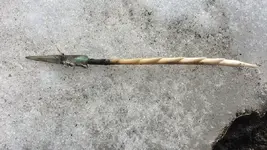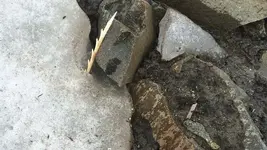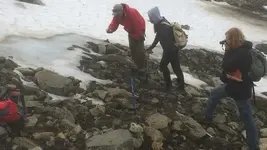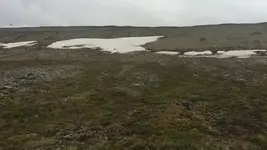DeepseekerADS
Gold Member
- Joined
- Mar 3, 2013
- Messages
- 14,880
- Reaction score
- 21,746
- Golden Thread
- 0
- Location
- SW, VA - Bull Mountain
- Detector(s) used
- CTX, Excal II, EQ800, Fisher 1260X, Tesoro Royal Sabre, Tejon, Garrett ADSIII, Carrot, Stealth 920iX, Keene A52
- Primary Interest:
- Other
'Incredible' 900-year-old copper arrowhead discovered on Canadian mountain | Fox News
By James Rogers | Fox News

Close up of barbed antler arrow point with copper end blade shortly after it was removed from the ice. (Government of Yukon photo)
A rare copper arrowhead discovered on a remote Canadian mountaint is almost 900 years old, archaeologists have confirmed.
The arrowhead, which is at the tip of a perfectly preserved antler arrow, was found sticking out of an ice patch in Canada’s Yukon Territory. The find, which was made in 2016 on an unnamed mountain, surprised experts.
“It was found near the top of a snow-capped mountain in South West Yukon,” Yukon Archaeologist Greg Hare told Fox News. “It was an incredible discovery, we really didn’t intend to be on that [ice] patch on that day."
The archaeologists were travelling in two helicopters with a documentary film crew when they noticed caribou on the ice patch they were planning to land on. Instead, the helicopter landed on a small nearby patch of snow where Senior Project Archaeologist Christian Thomas quickly spotted the arrow. “While we were there we thought we would look around and within five minutes Chris found this massive barbed antler point sticking out of the ice patch,” said Hare.

Close up of massive barbed antler point still entombed in ice. (Government of Yukon photo)
Including the barbed antler and the copper end blade, the arrow is about 11-inches long.
The weapon was sent to the University of Ottawa’s A.E. Lalonde laboratory for radiocarbon dating, where it was found to be about 850 years old.
The discovery, which was made in partnership with the Carcross/Tagish First Nations, is shedding new light on the history of the Canadian Territory.

Yukon ice patch researchers (left to right - Greg Hare, Nahanni Dynes and Michael Campbell) examining a barbed antler point shortly after its discovery at the edge of a small Yukon ice patch. (Government of Yukon photo)
“This is one of the earliest examples that we have bow and arrow technology in the Yukon and it’s the earliest known example of copper use in Yukon,” Hare said.
Archaeologists have recovered about 250 objects from melting ice patches in Southern Yukon, almost all of which have been bows and arrows or throwing darts.
“The advantage of the ice patch project is that most of what we’re finding has an organic element that lets us radiocarbon date it,” he added. “We will never find things like this in a lowland setting – [the arrow] is only preserved because it has been locked in the ice for basically 1,000 years,” Hare said.

The ice patch where the arrow was discovered, known locally as "Deuces Wild," seen from the helicopter. (Government of Yukon photo)
“Secrets from the ice,” the CBC documentary on the Yukon ice patches, aired late last year.
The arrow is not the only stunning archaeological find that has been preserved by ice. Last year a reindeer hunter found an 1,100-year-old Viking sword on a remote mountaintop in Southern Norway.
By James Rogers | Fox News

Close up of barbed antler arrow point with copper end blade shortly after it was removed from the ice. (Government of Yukon photo)
A rare copper arrowhead discovered on a remote Canadian mountaint is almost 900 years old, archaeologists have confirmed.
The arrowhead, which is at the tip of a perfectly preserved antler arrow, was found sticking out of an ice patch in Canada’s Yukon Territory. The find, which was made in 2016 on an unnamed mountain, surprised experts.
“It was found near the top of a snow-capped mountain in South West Yukon,” Yukon Archaeologist Greg Hare told Fox News. “It was an incredible discovery, we really didn’t intend to be on that [ice] patch on that day."
The archaeologists were travelling in two helicopters with a documentary film crew when they noticed caribou on the ice patch they were planning to land on. Instead, the helicopter landed on a small nearby patch of snow where Senior Project Archaeologist Christian Thomas quickly spotted the arrow. “While we were there we thought we would look around and within five minutes Chris found this massive barbed antler point sticking out of the ice patch,” said Hare.

Close up of massive barbed antler point still entombed in ice. (Government of Yukon photo)
Including the barbed antler and the copper end blade, the arrow is about 11-inches long.
The weapon was sent to the University of Ottawa’s A.E. Lalonde laboratory for radiocarbon dating, where it was found to be about 850 years old.
The discovery, which was made in partnership with the Carcross/Tagish First Nations, is shedding new light on the history of the Canadian Territory.

Yukon ice patch researchers (left to right - Greg Hare, Nahanni Dynes and Michael Campbell) examining a barbed antler point shortly after its discovery at the edge of a small Yukon ice patch. (Government of Yukon photo)
“This is one of the earliest examples that we have bow and arrow technology in the Yukon and it’s the earliest known example of copper use in Yukon,” Hare said.
Archaeologists have recovered about 250 objects from melting ice patches in Southern Yukon, almost all of which have been bows and arrows or throwing darts.
“The advantage of the ice patch project is that most of what we’re finding has an organic element that lets us radiocarbon date it,” he added. “We will never find things like this in a lowland setting – [the arrow] is only preserved because it has been locked in the ice for basically 1,000 years,” Hare said.

The ice patch where the arrow was discovered, known locally as "Deuces Wild," seen from the helicopter. (Government of Yukon photo)
“Secrets from the ice,” the CBC documentary on the Yukon ice patches, aired late last year.
The arrow is not the only stunning archaeological find that has been preserved by ice. Last year a reindeer hunter found an 1,100-year-old Viking sword on a remote mountaintop in Southern Norway.
Upvote
0




